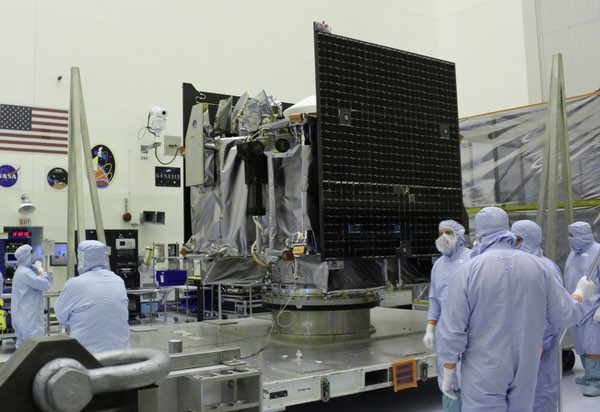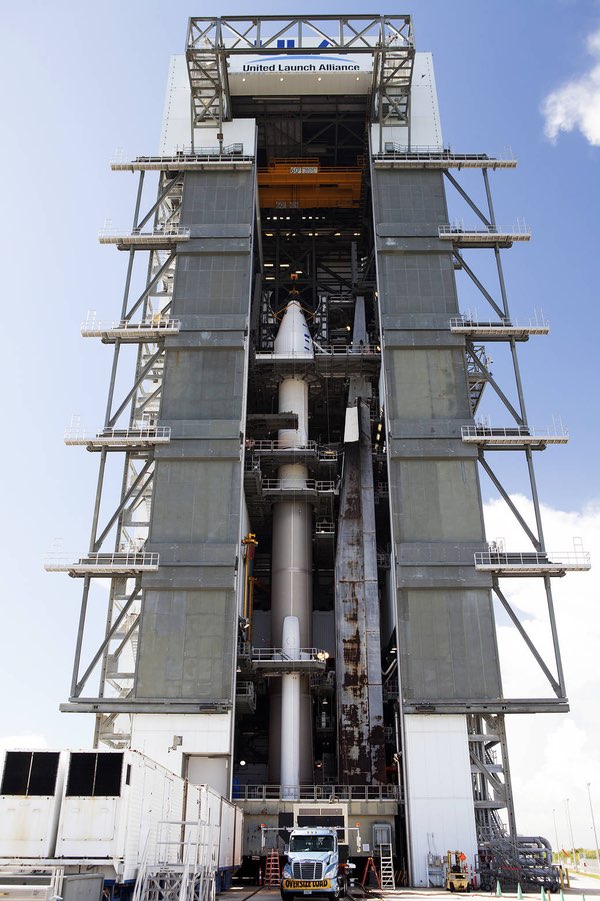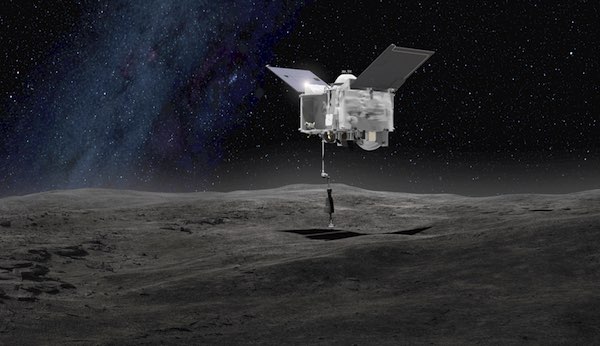A seven-year missionby Jeff Foust
|
| “It turned out somebody used a Solo cup and an air compressor in their driveway, and that’s actually what started the TAGSAM technology,” Kuhns said of the origins of the mission’s sample collection device. |
It’s a name and acronym—long, with a hyphen and an unexpected lowercase letter at the end—that’s caused some grumbling and ridicule among scientists and journalists (one of whom said she created a Word macro for the acronym to avoid the inevitable typos.) But it’s also very descriptive of the mission. “The mission objectives are captured in the awesome acronym that is OSIRIS-REx,” Dante Lauretta, the University of Arizona planetary scientist who is the principal investigator of the mission, said at a pre-launch briefing at NASA Headquarters last month.
And while others might disagree with Lauretta’s description of the OSIRIS-REx acronym as “awesome,” he is correct that the name accurately describes the mission and its goals, which go beyond simply studying a near Earth asteroid.
OSIRIS-REx is not the first asteroid sample return: Japan’s Hayabusa holds that honor, having returned a tiny amount of samples from the asteroid Itokawa in 2010. (It won’t be the second, either: Hayabusa-2, launched in 2014, is scheduled to collect samples from the asteroid Ryugu and return to Earth in late 2020.) It is, though, the most ambitious asteroid sample return mission to date, with a goal of returning at least 60 grams, and perhaps up to a few kilograms, of samples of Bennu to Earth in September 2023.
OSIRIS-REx will acquire those samples using an instrument with a similarly descriptive name: the Touch-and-Go Sample Acquisition Mechanism (TAGSAM). Mounted on the end of a robotic arm, TAGSAM will briefly touch the surface of Bennu for several seconds—touch and go—firing puffs of nitrogen gas as the sample head makes contact with the surface. That is designed to disturb bits of regolith from the surface that will be captured by filters in the instrument.
TAGSAM has humble origins. “This actually started as a contest where we wanted to know what is the best way to bring back a sample,” said Rich Kuhns, OSIRIS-REx program manager at Lockheed Martin, which built the spacecraft. “It turned out somebody used a Solo cup and an air compressor in their driveway, and that’s actually what started the TAGSAM technology.”
 OSIRIS-REx in a clean room at the Kennedy Space Center in Florida in May, a day after being shipped from the Lockheed Martin factory in Colorado where it was assembled. (credit: J. Foust) |
Assuming the sample collection is a success, the samples will be deposited in a sample return canister—effectively a copy of the one used on the Stardust mission that returned comet dust samples more than a decade ago—for return to Earth. If the first sampling attempt isn’t successful, there’s enough nitrogen gas on OSIRIS-REx for two more attempts.
| “We’re going after compounds that are literally at the part-per-billion level in these materials,” Lauretta said. “We have to get these samples into our laboratories.” |
Project officials are confident, though, that they’ll get their 60 grams or more the first time around. “We’ve tested the technology over a wide range of different materials,” Kuhns said. “We’ve tested it with lightweight materials, we’ve tested it with dense materials, we’ve tested it different sizes of materials, in order to understand how wide of a range of materials we’ll be able to collect.”
Kuhns said that during those tests they’ve collected “significantly more than we intend to collect,” with an average of more than 300 grams per attempt. Some of those tests have collected as many as two kilograms of material.
“I’ve watched the TAGSAM development since those early days, from when it was a Solo cup and an air compressor to the phenomenal flight unit that we have today,” Lauretta said. “Sixty grams? I’ve never seen a test that low.”
Why go through all that effort, though, to pick up 60 or 600 grams of asteroid material, though, when tons of asteroid material arrives on Earth each year, free of charge, in the form of meteorites? Lauretta, who started his career in meteorite science, argued in essence that you get what you pay for.
“We were frustrated in meteorite science by several key things,” he recalled. “Meteorites are uncontrolled samples: you don’t know where they came from, they have to pass through the Earth’s atmosphere, they experience alteration from that very energetic and dynamic process. They disrupt in the air, they get scattered over large footprints of the surface of the Earth, and they’re usually collected in a very uncontrolled way.”
“I compare it to a forensic investigation,” he continued. “With OSIRIS-REx, we will have control of the evidence from the time it was on the surface of the asteroid until it gets into our laboratories, so any contamination concerns are mitigated by that very careful handling.”
That desire to avoid contamination when bringing back samples is driven by the “Origins” in OSIRIS-REx’s name. “We seek samples that date back to the very dawn of our solar system, and we want to get them back into our laboratories to understand the processes that may have led to the origin of life and to the habitability of our planet,” Lauretta said.
That includes organic compounds that may exist on Bennu, but only in trace amounts that make it infeasible for the spacecraft to detect and analyze them at the asteroid. “We’re going after compounds that are literally at the part-per-billion level in these materials,” he said. “We have to get these samples into our laboratories so that we can bring cutting-edge analytical techniques, the kinds of things you just can’t fly on a spacecraft because they weigh too much or they require too much power, or they require a very careful lab technician to make the analysis possible.”
When those are returned, some will be immediately analyzed, and a few percent will be shared with partners in Canada and Japan (the latter in exchange for samples from the Hayabusa missions). But three-fourths of the samples will be set aside for later research by instruments yet to be developed, and perhaps scientists yet to be born. “Sample return is the gift that keeps on giving,” Lauretta said.
| “OSIRIS-REx is really a trailblazer for all future small-body missions,” including asteroid mining missions, Lauretta said. |
OSIRIS-REx will do more than return samples from Bennu. Once the spacecraft arrives at the asteroid in August 2018, it will study the asteroid in detail, both to better understand the asteroid and to identify locations on the surface to make sample collection attempts. Spectrometers, operating at visible and infrared wavelengths, will identify minerals, while an x-ray imaging system will map elemental abundances in the regolith.
Those studies will go towards the “Spectral Interpretation” and “Resource Identification” aspects of OSIRIS-REx. Bennu has already been studied in detail by ground- and space-based telescopes, collecting spectra of the asteroid. “Bennu is currently the best understood asteroid not yet visited by a spacecraft,” said Christina Richey, OSIRIS-REx deputy program scientist at NASA Headquarters.
OSIRIS-REx will allow scientists to compare those spectra with in situ observations by the spacecraft, which may help scientists better interpret spectroscopic observations of other asteroids. “We’re going to get data up close and personal with Bennu. We’re really going to be able to compare it to what we thought we learned from our telescopic observations,” Lauretta said.
 OSIRIS-REx, encapsulated inside its payload fairing, mounted atop its Atlas V rocket last week. (credit: NASA/Dimitri Gerondidakis) |
And then there’s that second “S” in OSIRIS-REx: Security. Bennu is a near-Earth asteroid that poses a very small—about 1 in 2,700—risk of colliding with the Earth in the late 22nd century. At about 500 meters in diameter, it would cause significant damage on a regional scale if it collided with the Earth.
NASA hopes OSIRIS-REx can help them better understand perturbations in the orbits of near Earth asteroids that affect the ability to accurately forecast impact risks. In particular, scientists plan to use OSIRIS-REx to measure the Yarkovsky effect, a small but steady force linked to the absorption and emission of solar radiation.
“We have a theory of how the Yarkovsky effect works,” Lauretta said. Asteroids absorb sunlight and re-radiate it as thermal emission, but with a lag that creates a net thrust that, over time, measurably adjusts the asteroid’s orbit. Data from several OSIRIS-REx instruments should confirm if that model works. “If it does, then we have great confidence that we understand the details of how the Yarkovsky effect works. If it doesn’t—and sometimes nature surprises you—then we’re going to have to go back and sharpen our pencils and refine our theory.”
There are even applications for OSIRIS-REx beyond science and planetary defense. “The ‘Resource Identification’ captures the interest and the investment that corporations and nations across the world are making in the potential for exploiting and developing asteroids,” said Lauretta, who is also an advisor to Planetary Resources, a company with long-term asteroid mining ambitions.
“OSIRIS-REx is really a trailblazer for all future small-body missions,” he added, based on both its science and the techniques it will use to navigate in the vicinity of an asteroid. “Any team that is going out there and planning to interact intimately with an asteroid, whether you’re planning on mining it, for future exploration, or you’re returning something back to the Earth, they’re going to take great advantage of all of these pioneering techniques that OSIRIS-REx developed. It’s one of our gifts for the future.”
That’s a lot for a single, mid-sized ($800 million plus launch and operations) planetary mission. OSIRIS-REx is the third in NASA’s New Frontiers program of medium-class missions. The first, New Horizons, flew past Pluto last year and earlier this year won approval for an extended mission to fly past a Kuiper Belt object at the beginning of 2019. Juno, the second New Frontiers mission, entered orbit around Jupiter two months ago.
NASA is also gearing up for a competition starting early next year to select the fourth New Frontiers mission, for launch by 2024 or 2025. That will be shortly after OSIRIS-REx completes its seven-year mission by returning its asteroid sample bounty to the Earth. (The rest of the spacecraft will fly past Earth at that time, although there are currently no plans for an extended mission using that spacecraft.)
“For me, the mission is driven by the return of pristine organic molecules from the early solar system. I’m really hopeful that we will get some unique material that isn’t in our meteorite collections,” Lauretta said, who said that desire has motivated him since he started working on the OSIRIS-REx mission concept—originally pitched, unsuccessfully, as a smaller Discovery-class mission before winning the New Frontiers competition in 2011—a dozen years ago.
“It really is a great adventure,” he said. “We are going out into the unknown. We are bringing back scientific treasure.”
